Lalida is a slightly-built woman, but she has the determined bearing of a revolutionary. On October 2, 2006, with two hundred other activists from Tamil Nadu in Southern India, she has come to Nagaloka, a Buddhist training center in the city of Nagpur–in the central Indian state of Maharashtra–to take a step they believe will spur radical social change: conversion to Buddhism. Reciting the ancient vows of commitment to the ideals and precepts of Buddhism, they stumble over unfamiliar Pali words: “I go for refuge to the Buddha, Dhamma, and Sangha.” Then come words in their native Tamil, and suddenly the group is reciting an additional twenty-two vows with intense conviction. Some vows enjoin commitment to Buddhism, while others fiercely reject the faith into which they were born: “I renounce Hinduism, which is harmful for humanity and impedes the advancement and development of humanity because it is based on inequality, and adopt Buddhism as my religion.” The vows culminate in a passionate expression of commitment: “I believe that I am having a rebirth.”
The Tamils’ fervor and their repudiation of Hinduism seem far from the equanimity that is generally associated with Buddhism, but members of Lalida’s community have a distinct perspective. They call themselves dalits, or “the oppressed,” but under the Hindu caste system they are “untouchables,” and their very presence is considered ritually polluting. For centuries their only work has been in “unclean” occupations like digging latrines and graves, and even though overt caste discrimination was outlawed after Indian independence in 1947, discrimination and violence continue and dalits remain much poorer and less educated than caste Hindus. Casteism is reminiscent of racism, but it goes deeper. Caste springs from religion, and that is why Lalida, following a path already taken by twenty million dalits, is seeking a religious solution in Buddhism.
Since 1956 dalits have been embracing Buddhism in these mass conversion ceremonies, and the Buddhist movement has become well established in Maharashtra. Now, the fiftieth anniversary of the first conversions has prompted a new wave that is taking Buddhism to dalits and similar communities well beyond Maharashtra, and this phenomenon raises many compelling questions for Buddhists. How meaningful can it be to adopt Buddhism en masse, rather than as an individual decision? Is conversion merely a political expedient, or does it have some relation to the path to enlightenment? And conversely, does the message of social change hold lessons for other Buddhists?
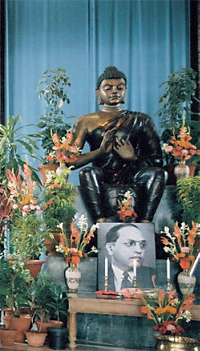
ON THE DAY OF Lalida’s conversion (she chose to drop her surname upon conversion), I joined a crowd of a million dalit Buddhists at a large piece of land in central Nagpur called Dikshabhumi—the place of diksha, or conversion—where the movement started. Although little-known even in India, this annual gathering is one of the world’s great pilgrimages: all day a great stream of people flooded into the grounds, many of whom had walked for days or traveled across India. Dikshabhumi is dominated by a huge stupa–a Buddhist ritual structure–and I joined the procession passing through the temple in its base. The pilgrims’ faces became intent, serious, and filled with devotion as we entered the temple and passed the urn containing the ashes of the movement’s iconic leader, Dr. Bhimrao Ambedkar.
Dr. Ambedkar led the first mass conversion at Dikshabhumi, adopting Buddhism alongside 380,000 followers on October 14, 1956. He was born an untouchable, but his education was sponsored by reform-minded patrons, and–surviving the hostility of high-caste classmates—Ambedkar won scholarships to Columbia University, where he became the first dalit to gain a Ph.D., and the London School of Economics. Returning to India, he became the undisputed leader of the dalits, whom he represented in the run-up to independence. As India’s first law minister, he was the chief architect of the constitution that has underpinned the country’s survival as a billion-strong secular democracy, guaranteeing equal rights, setting affirmative-action reservations for outcaste communities in education, parliament, and government employment, and outlawing many caste practices. These achievements established Dr. Ambedkar as the dalits’ revered hero–they call him Babasaheb (“beloved father”), Bodhisattva Ambedkar, and even “our savior.”Ambedkar is a problematic figure for Westerners who look to Asia for an alternative to our rational, materialist culture, because he himself looked to Western modernity as a refuge from the traditional Hindu worldview that perpetuated the caste system. His business-suited image could not be further from that of his contemporary and sometime foe, Mahatma Gandhi–a high-caste lawyer with a Western education who used traditional dress to dramatize his association with classic Indian values. Gandhi claimed these values to be superior, but Ambedkar identified them with superstition and inequality and wore Western clothes to dramatize a rejection of traditional India.
To understand Ambedkar’s rejection of Hinduism and his espousal of Buddhism, one must appreciate the depth of caste consciousness in India. The worst effect, Ambedkar believed, was the dalits’ internalization of the belief that they were impure; his radical insight—which broke with an ancient worldview—was that they could turn that notion on its head by rejecting the Hindu account of their position and choosing their own identity. In 1936, Ambedkar declared: “Although I was born a Hindu, I will not die a Hindu.” He also believed that religion was essential to human well-being, and–having rejected Marxism for its violence and materialism–he embarked on a study of the world faiths, seeking one that was in accordance with science, one that recognized the fundamental values of liberty, equality, and fraternity, and that did not sanctify poverty. He rejected the “foreign” traditions of Christianity and Islam for their theism and supernaturalism, and turned instead to Buddhism, which was born in India but had died out there centuries before despite its proliferation throughout the rest of Asia.
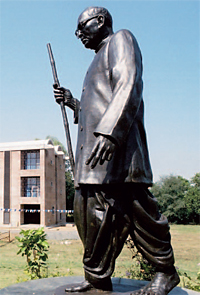
Ambedkar was attracted not by the Buddhism that existed in other Asian countries, but by the life and teachings of the Buddha himself. He saw the Buddha as “a common man” who offered guidance “to man in his life on earth” rather than offering himself as a gateway to salvation or promising it in the next life. For Ambedkar, the Buddha’s teachings stripped religion down to an essence that was in accordance with reason, experience, and a scientific outlook. Buddhist teachings affirmed human dignity, regardless of birth, and offered a rationale for individual moral effort that would benefit society at large. Indeed, Ambedkar thought he discerned a neglected dimension of the Buddha’s life, as a social reformer at war with India’s brahminical traditions and caste practices.
None of the existing Buddhist traditions quite fit Ambedkar’s approach, so he formulated–on no greater authority than his own understanding–what he considered to be the original teachings of the founder. In the last years of his life, Ambedkar compiled The Buddha and His Dhamma–part anthology, part biography of the Buddha, and part exposition of Ambedkar’s interpretations. Concerned that religion should benefit society, his Buddhism minimized or excluded the tradition’s ritual, psychological, and mystical dimensions, and saw morality as its essence. This may seem a narrow interpretation, but in Ambedkar’s view, Buddhist morality emphasizes the individual’s capacity to exercise responsibility, make ethical choices, and develop virtues. Not only does such a morality offer a foundation for a healthy society, he argued, but it also implies an open-ended path of practice and development.
Ambedkar’s rational, social Buddhism sometimes seems to mistake the enlightenment of the Buddha for that of eighteenth-century Europe. But by reconceiving Western ideas in the light of the Buddha’s teachings, he lends them depth. Liberty meant for him not just freedom from undue constraint, but also the opportunity to develop one’s faculties; equality meant solidarity with other human beings; and fraternity was the attitude of respect for others that is essential to a democracy.
Although Ambedkar interpreted Buddhism for his followers, he did not regard his version as definitive. The Buddha and His Dhamma is an unfinished sketch rather than a complete religious philosophy. Ambedkar urged his followers to study and practice the tradition for themselves and said he was opening a doorway to Buddhism. He urged his followers to engage with that path sincerely and effectively, and he added the twenty-two vows to the traditional conversion ceremony to ensure that their conversions made a lasting difference. The last vow states, “I shall hereafter lead my life according to the principles and teachings of the Buddha and his Dhamma.”
Ambedkar died in December 1956, just six weeks after the first mass conversions and before he could undertake the huge ceremonies he had planned across India. For many years the Ambedkarite Buddhist movement was hampered by factionalism, the absence of experienced Buddhist teachers, and the fact that Buddhist converts were long ineligible for the jobs and educational places that were reserved for other dalits. Nonetheless, it survived and gradually took hold, and today, the relative prosperity, educational achievements, and collective confidence of Maharashtra’s Buddhists is remarkable among dalit communities.
Shortly after my first visit to Dikshabhumi, I returned there to meet Professor Saddhananda Fulzele, who worked with Ambedkar and organized the 1956 ceremonies. We met at Dr. Ambedkar College, which adjoins the Dikshabhumi site and was founded by Fulzele in 1963. He told me, “I decided to start the College as the most fitting memorial to Dr. Ambedkar, whose constant message was,’Educate!’” It has developed into a top-ranking institution, schooling generations of dalit professionals, and its success exemplifies the strides made by Ambedkarite Buddhists. Meanwhile, Ambedkar’s reputation has spread as his writings have been translated into India’s vernacular languages, and even among Ambedkar’s followers his reputation has been burnished by decades of disillusionment with corrupt politicians. As Fulzele commented, “Dr. Ambedkar dead is more powerful than he was alive.”
LALIDA EXEMPLIFIES THE dalit leaders who are now turning to Buddhism. Her family benefited from dalit reservations in government service, and she grew up comfortably, but still she could not escape caste. “I was ignored by my teachers, so I had little interest in study, but I loved working with ordinary people, and I saw how life is for dalit villagers.” As a response, she has built a network of activists who run programs offering education, opposing child labor, fighting for land rights, and supporting women’s empowerment in hundreds of villages. She is deeply committed to her community and, remarkably for an Indian woman, has decided not to have children so she can focus on social work. After years of effort, she sees signs of change, especially among women. “Dalit women are becoming stronger–running savings schemes, educating themselves, standing in elections, opposing domestic violence. I believe the whole dalit movement is rising, and for the first time we are united.”
Tamil dalits knew little about Ambedkar in his lifetime, but their recent discovery of his ideas and those of Buddhism has focused and deepened this new unity. Lalida explains, “I heard about Dr. Ambedkar in 1996, after his works were translated into Tamil. He said that our problems spring from Hinduism, that we needed to believe in ourselves and that the path was by becoming Buddhists.” The link to Nagaloka (which is connected to my own sangha, the Western Buddhist Order) came through its training course for young dalits in Buddhism and social work. Lalida told me, “One of our friends was studying at Nagaloka, so three years ago we visited Maharashtra. What we saw here was wonderful: the numbers at Dikshabhumi, the harmony between people, the welcome we received. We thought, ‘We want a movement like this in our own state.’” Having adopted Buddhism, she is now applying the same commitment she has shown in her social work to more traditional Buddhist practices. “At first some people laughed at the idea of meditation. They said, ‘Why do you sit around doing nothing?’ But we watched and learned, and now we are ready to take it on. Buddhism shows us what we can become, but we must learn how to practice it: how to live ethically and develop our minds.”
Ambedkar was attracted not by the Buddhism that existed in other Asian countries, but by the life and teachings of the Buddha himself. He saw the Buddha as “a common man” who offered guidance “to man in his life on earth” rather than offering himself as a gateway to salvation or promising it in the next life. For Ambedkar, the Buddha’s teachings stripped religion down to an essence that was in accordance with reason, experience, and a scientific outlook. Buddhist teachings affirmed human dignity, regardless of birth, and offered a rationale for individual moral effort that would benefit society at large. Indeed, Ambedkar thought he discerned a neglected dimension of the Buddha’s life, as a social reformer at war with India’s brahminical traditions and caste practices.
None of the existing Buddhist traditions quite fit Ambedkar’s approach, so he formulated–on no greater authority than his own understanding–what he considered to be the original teachings of the founder. In the last years of his life, Ambedkar compiled The Buddha and His Dhamma–part anthology, part biography of the Buddha, and part exposition of Ambedkar’s interpretations. Concerned that religion should benefit society, his Buddhism minimized or excluded the tradition’s ritual, psychological, and mystical dimensions, and saw morality as its essence. This may seem a narrow interpretation, but in Ambedkar’s view, Buddhist morality emphasizes the individual’s capacity to exercise responsibility, make ethical choices, and develop virtues. Not only does such a morality offer a foundation for a healthy society, he argued, but it also implies an open-ended path of practice and development.
Ambedkar’s rational, social Buddhism sometimes seems to mistake the enlightenment of the Buddha for that of eighteenth-century Europe. But by reconceiving Western ideas in the light of the Buddha’s teachings, he lends them depth. Liberty meant for him not just freedom from undue constraint, but also the opportunity to develop one’s faculties; equality meant solidarity with other human beings; and fraternity was the attitude of respect for others that is essential to a democracy.
Although Ambedkar interpreted Buddhism for his followers, he did not regard his version as definitive. The Buddha and His Dhamma is an unfinished sketch rather than a complete religious philosophy. Ambedkar urged his followers to study and practice the tradition for themselves and said he was opening a doorway to Buddhism. He urged his followers to engage with that path sincerely and effectively, and he added the twenty-two vows to the traditional conversion ceremony to ensure that their conversions made a lasting difference. The last vow states, “I shall hereafter lead my life according to the principles and teachings of the Buddha and his Dhamma.”
Ambedkar died in December 1956, just six weeks after the first mass conversions and before he could undertake the huge ceremonies he had planned across India. For many years the Ambedkarite Buddhist movement was hampered by factionalism, the absence of experienced Buddhist teachers, and the fact that Buddhist converts were long ineligible for the jobs and educational places that were reserved for other dalits. Nonetheless, it survived and gradually took hold, and today, the relative prosperity, educational achievements, and collective confidence of Maharashtra’s Buddhists is remarkable among dalit communities.
Shortly after my first visit to Dikshabhumi, I returned there to meet Professor Saddhananda Fulzele, who worked with Ambedkar and organized the 1956 ceremonies. We met at Dr. Ambedkar College, which adjoins the Dikshabhumi site and was founded by Fulzele in 1963. He told me, “I decided to start the College as the most fitting memorial to Dr. Ambedkar, whose constant message was,’Educate!’” It has developed into a top-ranking institution, schooling generations of dalit professionals, and its success exemplifies the strides made by Ambedkarite Buddhists. Meanwhile, Ambedkar’s reputation has spread as his writings have been translated into India’s vernacular languages, and even among Ambedkar’s followers his reputation has been burnished by decades of disillusionment with corrupt politicians. As Fulzele commented, “Dr. Ambedkar dead is more powerful than he was alive.”
LALIDA EXEMPLIFIES THE dalit leaders who are now turning to Buddhism. Her family benefited from dalit reservations in government service, and she grew up comfortably, but still she could not escape caste. “I was ignored by my teachers, so I had little interest in study, but I loved working with ordinary people, and I saw how life is for dalit villagers.” As a response, she has built a network of activists who run programs offering education, opposing child labor, fighting for land rights, and supporting women’s empowerment in hundreds of villages. She is deeply committed to her community and, remarkably for an Indian woman, has decided not to have children so she can focus on social work. After years of effort, she sees signs of change, especially among women. “Dalit women are becoming stronger–running savings schemes, educating themselves, standing in elections, opposing domestic violence. I believe the whole dalit movement is rising, and for the first time we are united.”
Tamil dalits knew little about Ambedkar in his lifetime, but their recent discovery of his ideas and those of Buddhism has focused and deepened this new unity. Lalida explains, “I heard about Dr. Ambedkar in 1996, after his works were translated into Tamil. He said that our problems spring from Hinduism, that we needed to believe in ourselves and that the path was by becoming Buddhists.” The link to Nagaloka (which is connected to my own sangha, the Western Buddhist Order) came through its training course for young dalits in Buddhism and social work. Lalida told me, “One of our friends was studying at Nagaloka, so three years ago we visited Maharashtra. What we saw here was wonderful: the numbers at Dikshabhumi, the harmony between people, the welcome we received. We thought, ‘We want a movement like this in our own state.’” Having adopted Buddhism, she is now applying the same commitment she has shown in her social work to more traditional Buddhist practices. “At first some people laughed at the idea of meditation. They said, ‘Why do you sit around doing nothing?’ But we watched and learned, and now we are ready to take it on. Buddhism shows us what we can become, but we must learn how to practice it: how to live ethically and develop our minds.”
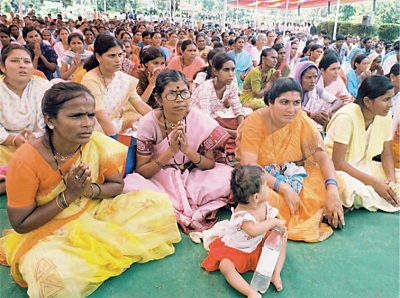
Such sincerity can be set against the natural suspicion of many outside observers that Ambedkarite Buddhism is a proxy for dalit social advancement and hatred of Hinduism. By no means are all Ambedkarite Buddhists as serious as Lalida. In Hyderabad, in the southeastern state of Andhra Pradesh, I attended a farcical rally that was billed as a gathering of three hundred thousand, including one hundred thousand new converts. It started badly when the stage collapsed beneath the assembled dignitaries, and it quickly became clear that the numbers attending would be closer to a thousand. The meeting had been hijacked by a local politician who inflated the anticipated numbers and alienated local Buddhists by involving right-wing Hindu politicians. This fractious, chaotic, hyperbolic side of Ambedkarism is rife in Maharashtra, too, and has led to some skepticism among outsiders.
My roommate at Nagaloka was Christopher Queen, an ebullient man who teaches religion and engaged Buddhism at Harvard and seems to know everyone in the Ambedkarite world. After the Nagaloka diksha ceremony he articulated another concern: “What do they mean, ‘All India will become Buddhist’? The new converts will continue to live in a land of Hindus, Muslims, and all the rest. Ambedkar refocused Buddhist teachings to empower dalits. But he also persuaded the Hindu majority to adopt a constitution that outlawed untouchability.” Queen added that he believes Ambedkarites should drop the extra vows that forbid Hindu beliefs and practices. “They need to say what they are for – the traditional refuges and precepts – and leave Hinduism out of it. Why incite the Hindu nationalists all over again?”
When I put this to Ambedkarites, they answered that they do oppose Hinduism and caste practice but that they do not hate Hindus personally, and the vows ensure that the meaning of becoming a Buddhist is clear. A BBC journalist I met in Hyderabad was incredulous that a mass conversion ceremony could change centuries-old customs. My dalit friends insisted that however incredible it may seem, this really does happen. The vows ensure clarity; a more fundamental reason, however, is that the new converts were never wholly part of Hinduism, which barred them from its temples–dalit village gods are often protector spirits rather than Hindu deities. Their real faith–often quite amazing in its intensity–is in Dr. Ambedkar, and for most, engagement with Buddhism is an extension of that devotion.
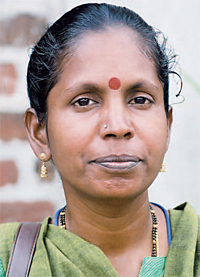
AS AN INTELLECTUAL AND POLITICIAN, Ambedkar is far from the image of Indian religious teachers favored by Westerners, but perhaps he is better seen as a prophet than a saint, fired by moral outrage and social vision. Ambedkar’s Buddhism challenges the view that Buddhism teaches an inner personal development that remains apart from the world’s struggles. His thought combines the social and individual realms through the conviction that lasting change can only spring from individual moral development and peaceful collective action. Conversely, Ambedkar believed that a meaningful human life requires not withdrawal but fuller engagement with others. This vision of spiritual life as a struggle to change oneself and the world is a bracing alternative to the quietist, introspective approach more popular in the West.
If one considers the community’s poverty and lack of education, the movement’s politicization and lack of spiritual depth is hardly surprising. But as Professor Fulzele commented, “Fifty years is a short time in the history of any religious movement,” and Ambedkarite Buddhism may only now be starting to fulfill its potential. Dalit Buddhists have made considerable material progress, and many have taken up formal dharma practice. The current wave of conversions marks a considerable expansion in the movement’s scope. It is hard to estimate how many will adopt Buddhism in this current wave of conversions, but the number is certainly in the tens of thousands and will probably reach hundreds of thousands. Many of the new convertees are leaders in their own dalit communities and they plan to spread the word of Ambedkar’s Buddhism in villages and slums across India, where little is known about Ambedkar or the movement he spawned.
To witness how Buddhism is affecting India’s rural heartlands, I left the world of Buddhist activists, politics, and movements, and traveled to the remote central Indian state of Chhattisgarh to join a dharma teaching tour of dalit villages led by Subhuti, an English member of the Western Buddhist Order. In contrast to the modernizing India that I saw in Maharashtra, Andhra Pradesh, and Tamil Nadu, Chhattisgarh is barely out of the Middle Ages. One afternoon we stopped our jeep beside a water hole, where buffalo lay neck-deep in the water, to garland a statue of Ambedkar that stood incongruously in a lush green field. Then we drove to a village of roughly built mud-walled huts. The entire village was there to meet us: 150 people clustered together by a lake filled with lotuses. Their faces expressed pleasure, mixed with incredulity that anyone should trouble to speak with them.
Most of the audience were Satnamis, a community of four million followers of the “true name” sect, an anticaste devotional movement teaching that social differences disappear in the face of Truth. Its eighteenth-century founder, Guru Ghasidas, rejected so many Hindu beliefs that his followers regard their tradition as independent and increasingly connect it with Buddhism. As a schoolteacher from the village told me, “Both teach equality and oppose caste. We love Guru Ghasidas, but the Satnami way has not helped our people out of suffering. Babasaheb Ambedkar has helped, so we have faith in him. Buddhism shows how to live a good life, so now we have faith in the Buddha.”
Throughout my trip I heard such simple, heartfelt professions of faith, strongly connected with an agenda of social change. When Saddhananda Fulzele described the 1956 conversion, he told me, “I cannot describe what I felt that day–I do not have the words in English–but it was as if our lives started anew. After so many centuries, people who had been treated as slaves and outcasts came to know that we are no less than anyone else. That was a great change, and what we gained was confidence in ourselves.”
In Chhattisgarh, the crowds chanted Ghasidas’s words “All humans are equal,” a simple slogan that challenges millennia of discrimination. A Chhattisghari singer accompanied our tour, transforming the dharma talks into poetry, which he recited in an emphatic, strongly-rhymed verse like Jamaican dub, and then he sang them in a vibrant, modulated harmony, swaying as the audience nodded with pleasure. Traditionally preachers here would recite verses from the Hindu classic the Ramayana, but many have turned against the text’s caste teachings. They have composed new works–their own epics–using the same forms: aBuddhayana, recounting the life of the Buddha, and a Bhimayana, telling the life of “Bhim” Ambedkar. Such cultural transformations demonstrate that for the new converts, Buddhism is far more than a new label. They are creating a new religious tradition, a new form of Buddha-dharma that grows from new myths and addresses their deepest needs and aspirations.
Nomads and Thieves turn to the Buddha
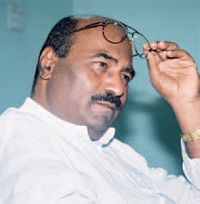
One group that can claim to fall below even the untouchables are the fifty million members of India’s “nomadic and criminal tribes.” Like Europe’s gypsies, they follow a rootless existence, on the edges of society, constantly traveling and begging food or foraging for scraps. The criminal castes survive by stealing.
Because they are homeless, these groups fail to register in government statistics, so they miss out on welfare programs and cannot vote–generations of politicians have ignored them with impunity. Many have been gathered into compounds supported by the barest amenities. “These are like ghettos or concentration camps,” their leader, the writer and activist Lakshman Mane, told me.
In a ceremony at Dikshabhumi on October 1, Mane became a Buddhist, along with 140 tribal leaders from the state of Maharashtra. When we met two days after his conversion, he told me, “We left the ceremony different people from the ones who had started it, filled with inspiration and confidence. It was a sudden, dramatic shift.” In a monthlong tour, these leaders will rally their community to a grand conversion meeting in Bombay, where at least five hundred thousand will become Buddhists. Mane, a short, solidly built man with an air of sturdy determination, was born into a thieving caste and grew up traveling from place to place, an upbringing described in his autobiographical novel Upara. I asked how he had gained an education. “I went to school–hundreds of schools. We moved on every few days, but wherever we went I was determined to get schooling. Some teachers accepted me into their class, others did not.” Mane eventually won a place at a college and gained a B.A.–an extraordinary achievement in a community with 0.6 percent literacy. Since publishing Upara in 1981, he has written sixteen other books highlighting his people’s plight.
Mane does not see becoming a Buddhist as conversion. “I was born into the tribal system, not Hinduism. We have no caste; we are not even untouchables. We don’t believe in karma or reincarnation, and don’t worship Hindu gods. The tribal system is like Buddhism. We travel from place to place, like Buddhist monks, and live between the village and the country. We share everything; if one person gains food or money, they share it with everyone else. There is no social status, and men and women are equal.”
Mane turned from revolutionary politics when he discovered Dr. Ambedkar. “Babasaheb gave us our rights when he framed the constitution that treats us as human beings. The problem is that those in power still treat us like animals.” In adopting Buddhism, Mane has made common cause with other Ambedkarites. “The dalits are our elder brothers, and I want to join with them. I want my people to have their just share in power, property, and social standing.
“My people need to move away from superstition and harmful livelihoods like stealing. But our main priorities are housing and education. Housing comes first, because without a stable base nothing else is possible. Now that we have organized ourselves and taken diksha, the government is paying attention in a way it has never done before. Buddhist teaching will follow, but for now we need help, and we look to our elder brothers in Maharashtra, to Buddhists around the world, and to foreign governments and NGOs. But today I am filled with new life and hope for the future.”